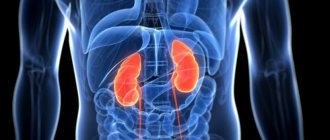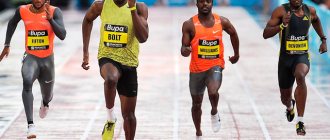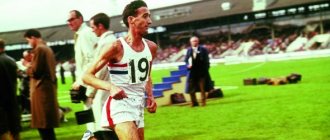Triathlon is gaining increasing popularity in Russia. The main goal of the triathlon hobby for many is to overcome the full Ironman distance. Ironman is the classic and longest distance in triathlon: 3.8 km swim, 180 km bike race, 42.2 km run. Many new triathletes wonder: is it possible to start straight away with an Ironman or should you choose a short race as your first triathlon start? Today we will look into this issue.
Triathlon distances:
- Full distance – 3.8/180/42.2
- “Half” – 1.9/90/21.1
- Olympic distance – 1500/40/10
- Sprint – 750/20/5
- Super sprint – 300/8/2
Beginning athletes think that the shorter the distance, the easier it is. Most coaches advise starting your sports journey with sprinting. It is believed that this fairly short race can be done by almost every person, if there are no health restrictions. Let's take a closer look at each distance and the difference in preparation and completion to answer the question - will short-distance competitions help prepare for the classic Ironman?
Distances in triathlon differ mainly in:
- preparation;
- nutrition at the race;
- drafting;
- equipment.
Drafting is riding a bicycle behind a cyclist in front with the goal of getting into a hole of rarefied air that forms behind the cyclist, and as a result, reducing your own air resistance. According to various estimates, drafting saves on average 30% of energy. This gives a chance to those athletes who do not have the qualities of a fast swimmer, and also do not work out the transit zone at the speed of professional athletes, to catch up with their opponents in the cycling stage.
Full distance 3.8/180/42.2
Preparation
When training for the full Ironman distance, most training is done at a low heart rate with gradual increases in intensity and duration. At the classic distance and half distance, drafting is prohibited. An impressive distance on the bike stage makes it possible to reveal your full potential and accumulated base.
Nutrition
The body is able to work on glycogen reserves for about 2 hours. Without additional nutrition, the athlete will feel severe hunger, will not be able to produce the planned power, and, possibly, will not complete the distance. The choice of nutrition is individual, so it must be worked out in training, rehearsing the passage of a real route and preparing the stomach for the chosen type.
Bike
A cutting bike allows you to:
- drive faster by reducing air resistance. The bike frame is more streamlined. The geometry of the frame allows the athlete to take a more streamlined position. To make the decision to buy a time trial bike, it is important to understand that the real advantage in terms of aerodynamics will only be at riding speeds of about 35 km/h and above.
- Take a more comfortable position. The athlete will be less tired and the muscles used when running will be less used.
History of the test
The history of Iron Man, as well as all modern triathlon in general, dates back to 1978, when the first race took place, the organizer of which is considered to be the then commander of the US Navy Expeditionary Forces in Hawaii, John Collins.
It was he and his wife Judy who came up with the idea to try to find out which sport has the greatest endurance. 15 people took part in the first competition in the new sport, but only 12 of them managed to reach the finish line. The winner was US Navy serviceman Gordon Haller, who took 11 hours, 46 minutes and 58 seconds to cover the entire distance. The current records look much more impressive: 8:01:40 for men, set by German athlete Patrick Lange, and 8:46:46 for women, owned by Daniele Ryf from Switzerland. During its relatively short existence, Iron Man competitions have gained worldwide popularity and almost universal distribution. Various modifications have appeared with the distance shortened by half or, conversely, doubled. But all of them do not have the right to use the Iron Man brand in their name. For example, a “halved” triathlon is called the “70.3 series.” These competitions have been held since 2005 and have the following distances in miles: 1.2-56-13.1.
"Half" 1.9/90/21.1
It also takes a lot of time to prepare for the “half” distance, although significantly less than for the full distance. At this distance you need to eat, use the same equipment and bike. We see that the “half” is a rehearsal for a long distance, since nutrition is present and plays an important role, and the energy supply zone is generally the same. The only difference is the transit time.
marathon and half marathon training plans and start training today!
Short distances
Preparation
Preparation for shorter distances will not require as much time from you. But all training takes place mainly in speed mode. A person with an unprepared heart simply physically cannot work constantly at a high heart rate. There can be two scenarios for the development of events:
- or you will do certain heart rate-based workouts, but with less intensity. In this case, the speed qualities that are so necessary for short distances do not develop.
- Or you do everything with the required intensity, but due to the constantly high pulse, rapid acidification occurs and the process of “underrecovery” of the body begins. In this case, you work “in debt” to the body during training, and approach competitions in a “squeezed lemon” state.
Race
Short distances differ in tactics, energy supply zone and nutrition from long ones and, as a rule, drafting is allowed at them. This means you can ride in a group and chase those in front. It rarely happens that organizers prohibit drafting.
The main nuances of tactical preparation for short distances with permitted drafting:
- fast swimming with the leading group and fast transit after. If you fail to be with the leaders after swimming, then there is no chance of catching up with a group of athletes alone. Naturally, the faster and fresher runner will gain time on the run, but if the group did not bring him to the second transit, then he will not be able to catch up with anyone.
- Ability to ride confidently in a group.
Let's look at the super sprint separately. Travel time is about 30 minutes. In this case, there is absolutely no talk about nutrition at a distance. The tactics of passing are the same as at the Olympic distance. The energy supply zone is mixed throughout the entire distance. To put it simply, you are in severe nitrous the entire distance.
Triathlon equipment
Frankly speaking, triathlon is not the most accessible sport, rather even an elite one. At a minimum, you need to have all the equipment of a swimmer, cyclist and runner. In addition to this, there are also specific triathlon items, such as a wetsuit. We will devote a separate article to equipment, where we will consider in detail what a triathlete needs.
Play sports, move and travel! If you find a mistake or want to discuss the article, write in the comments. We are always happy to communicate.










